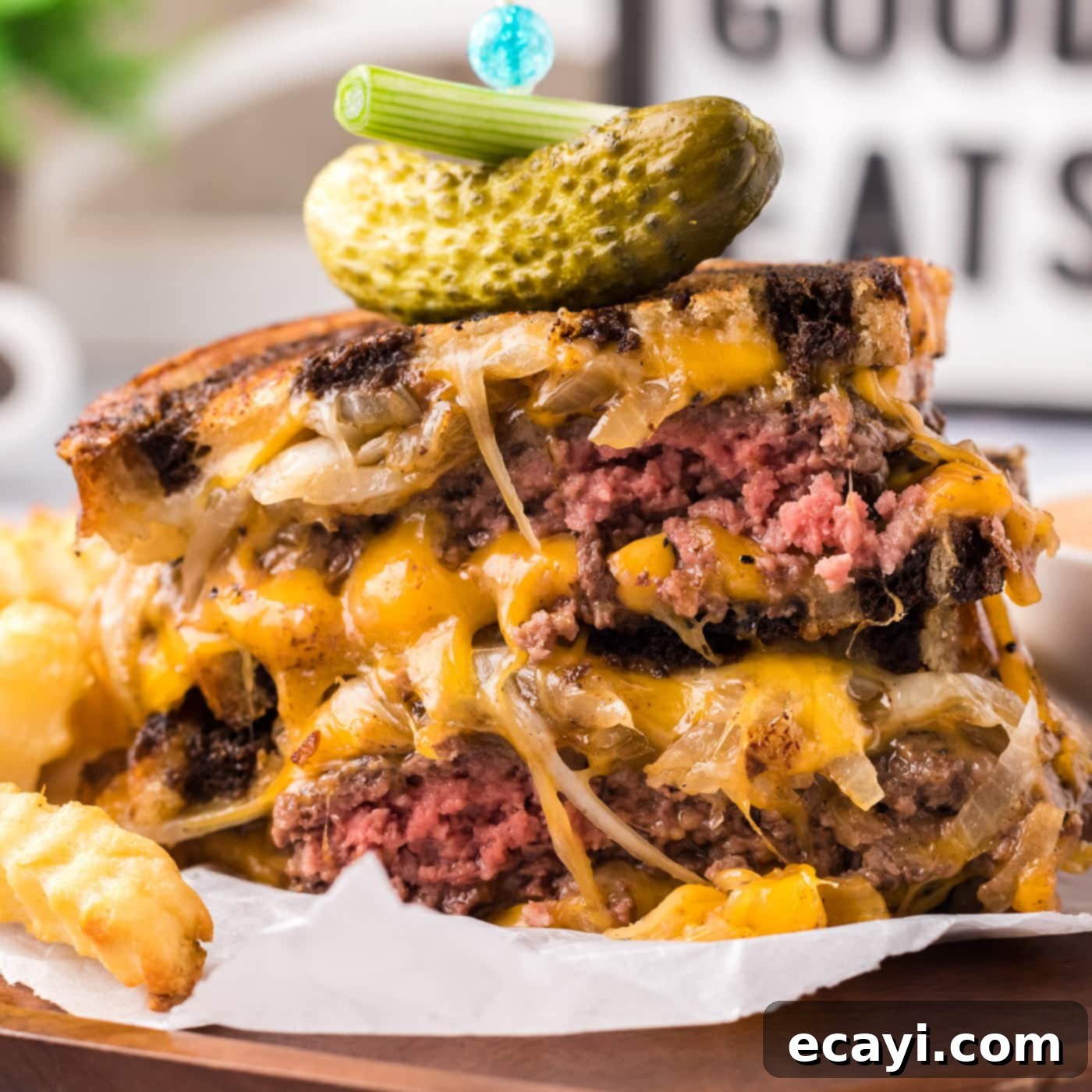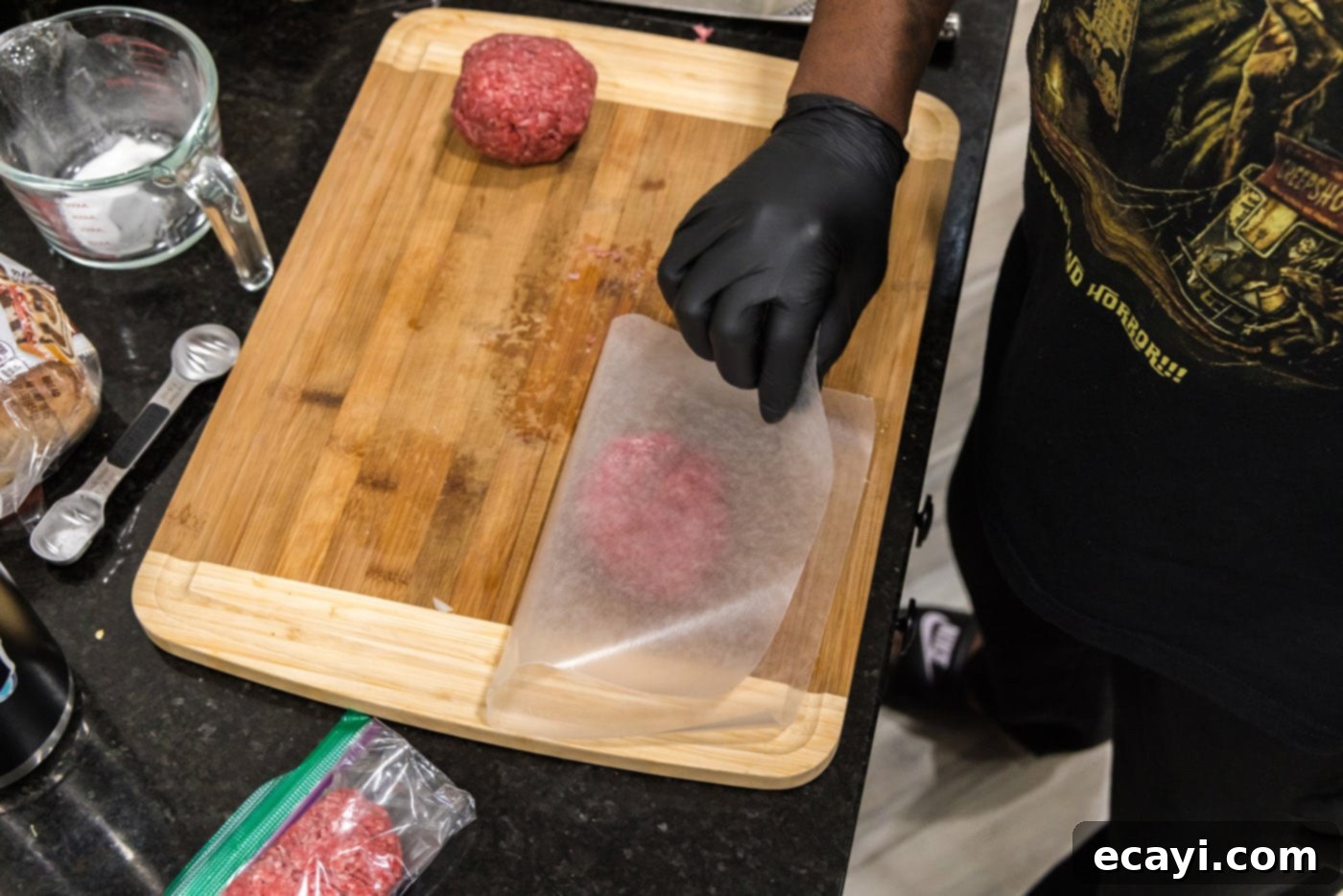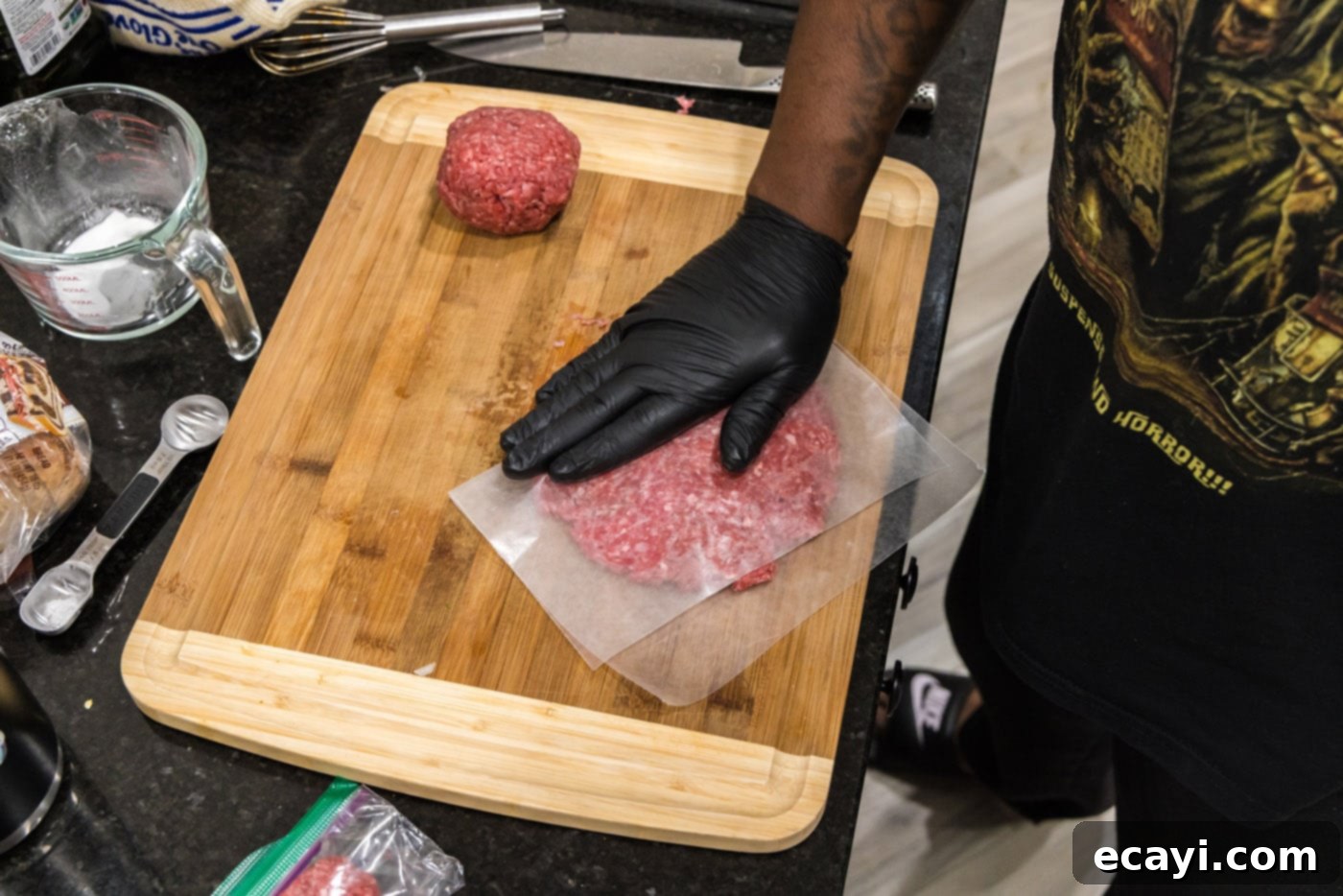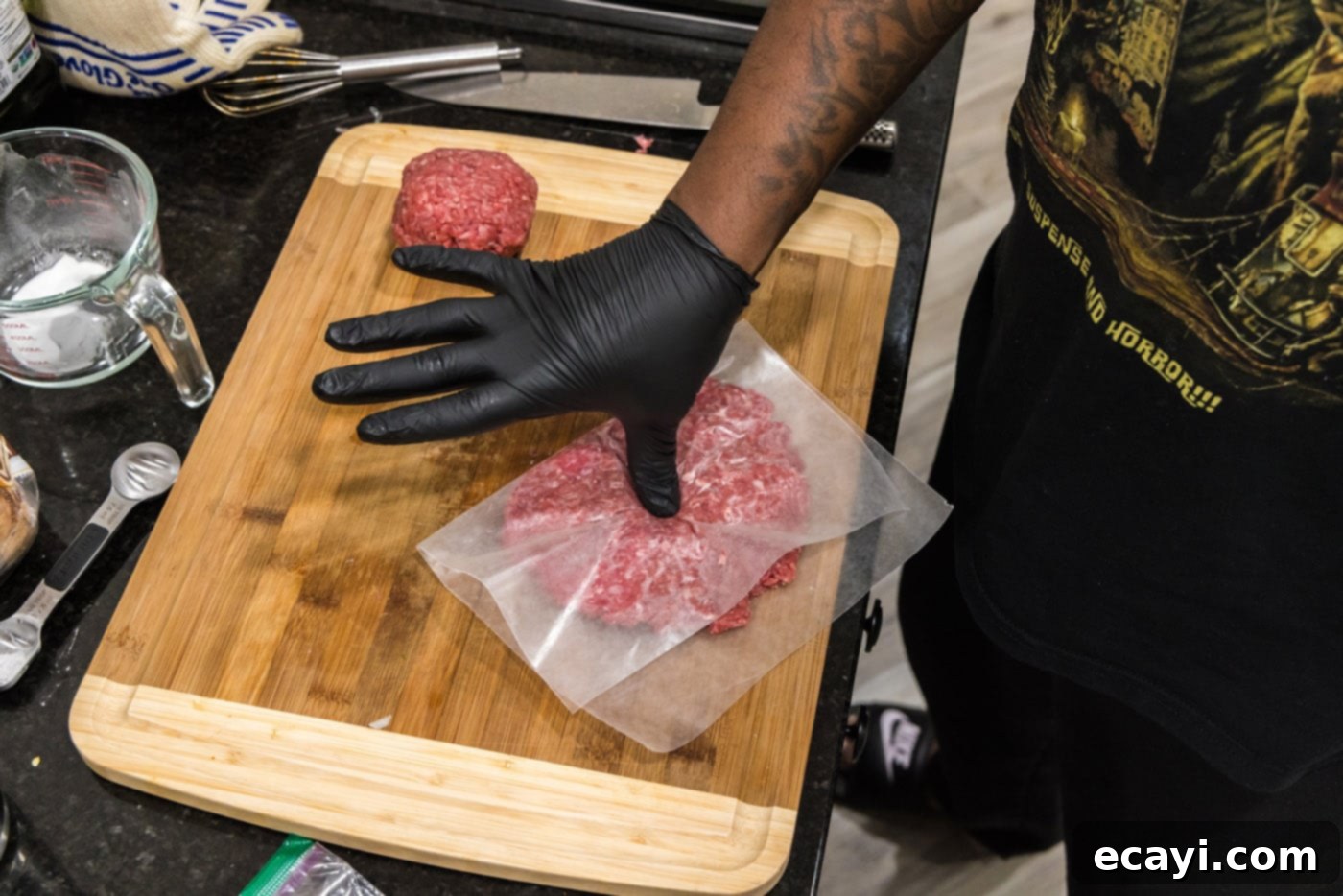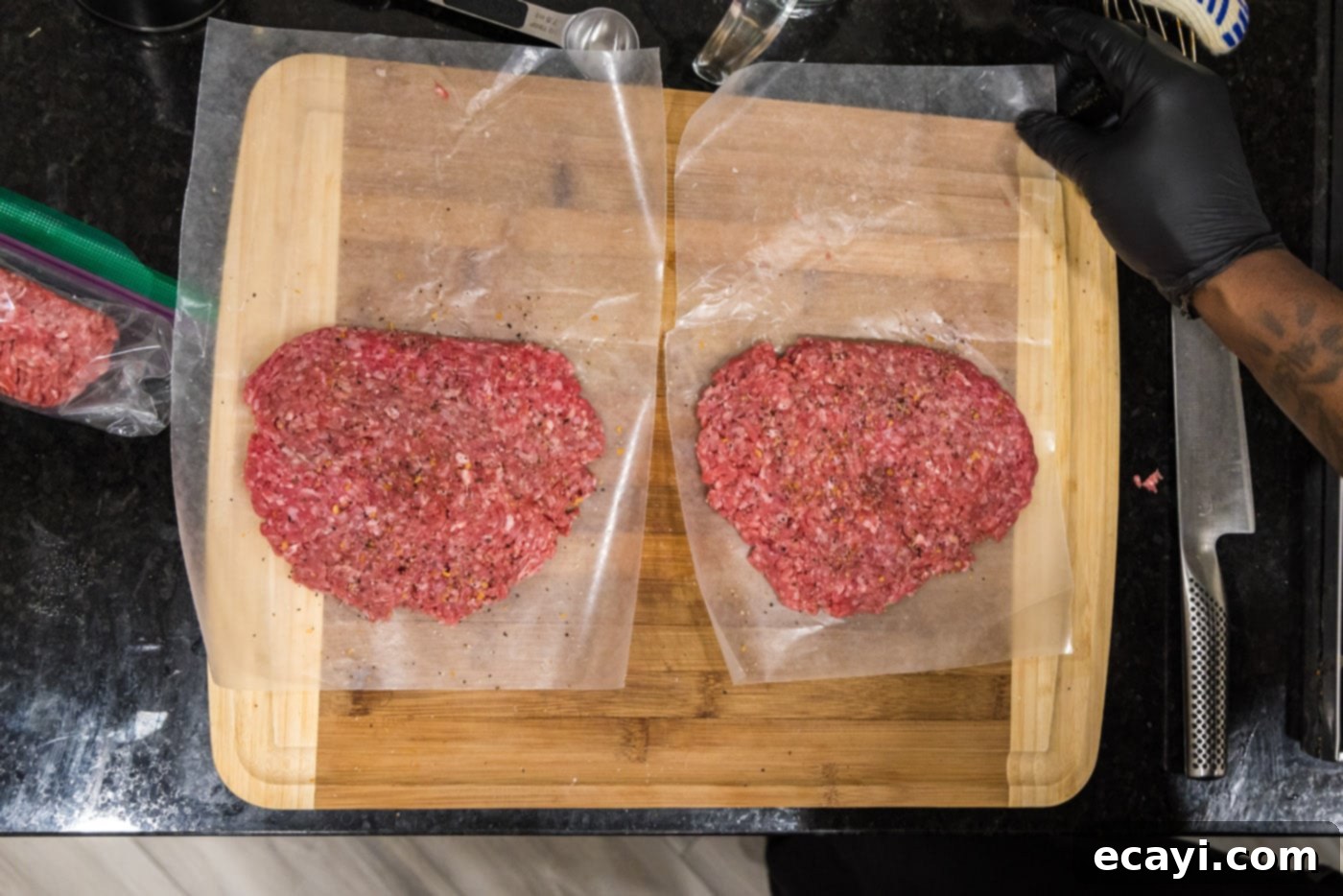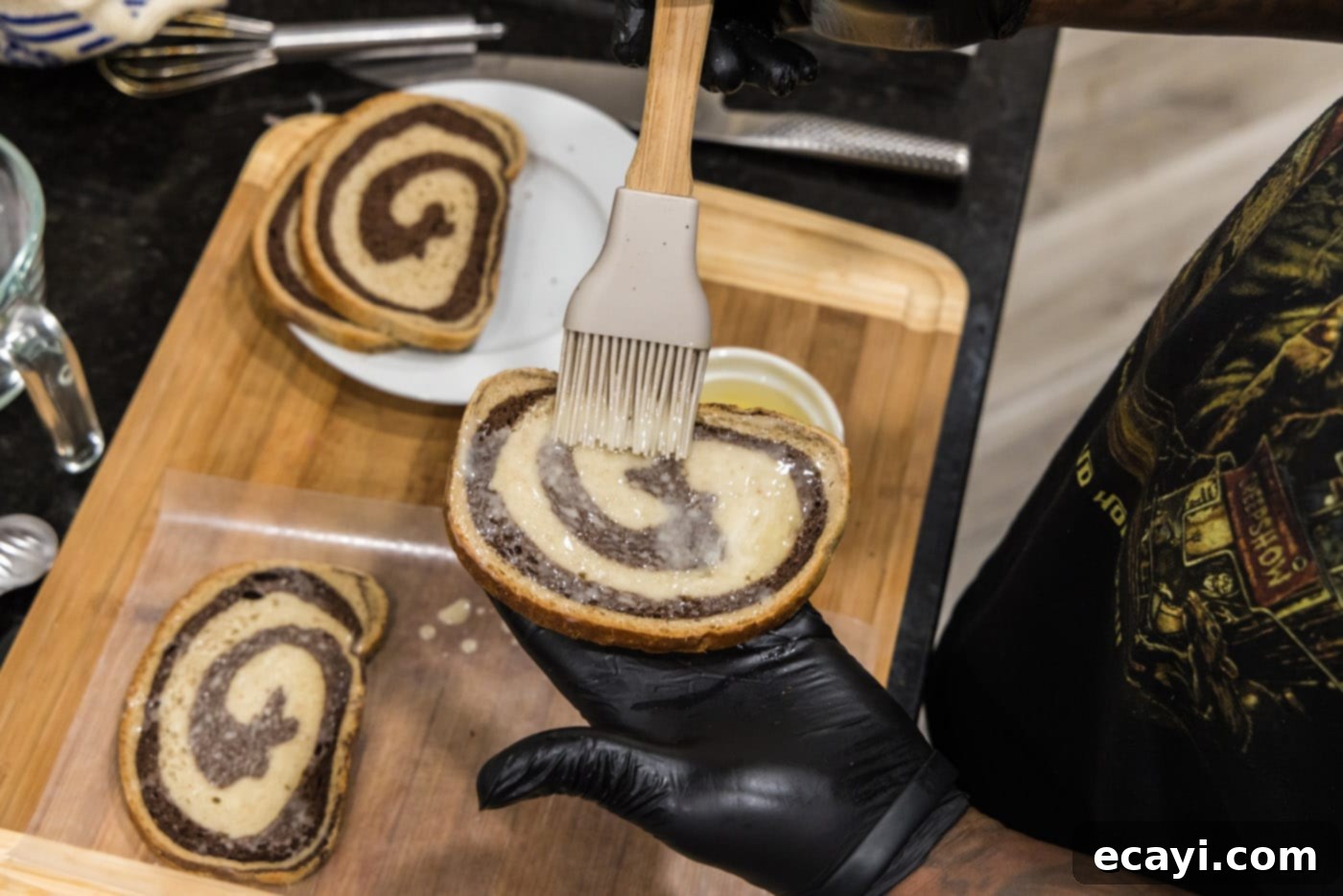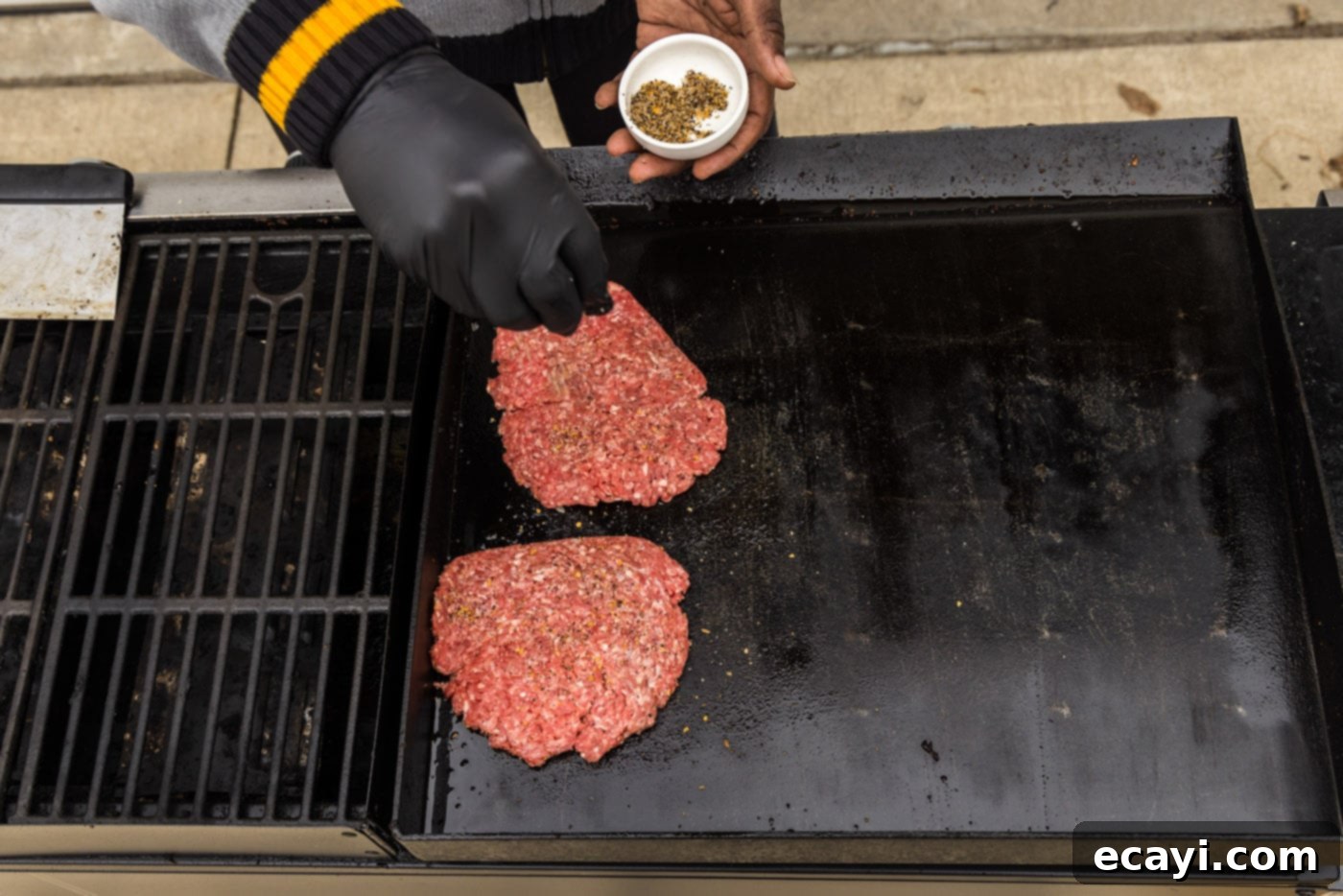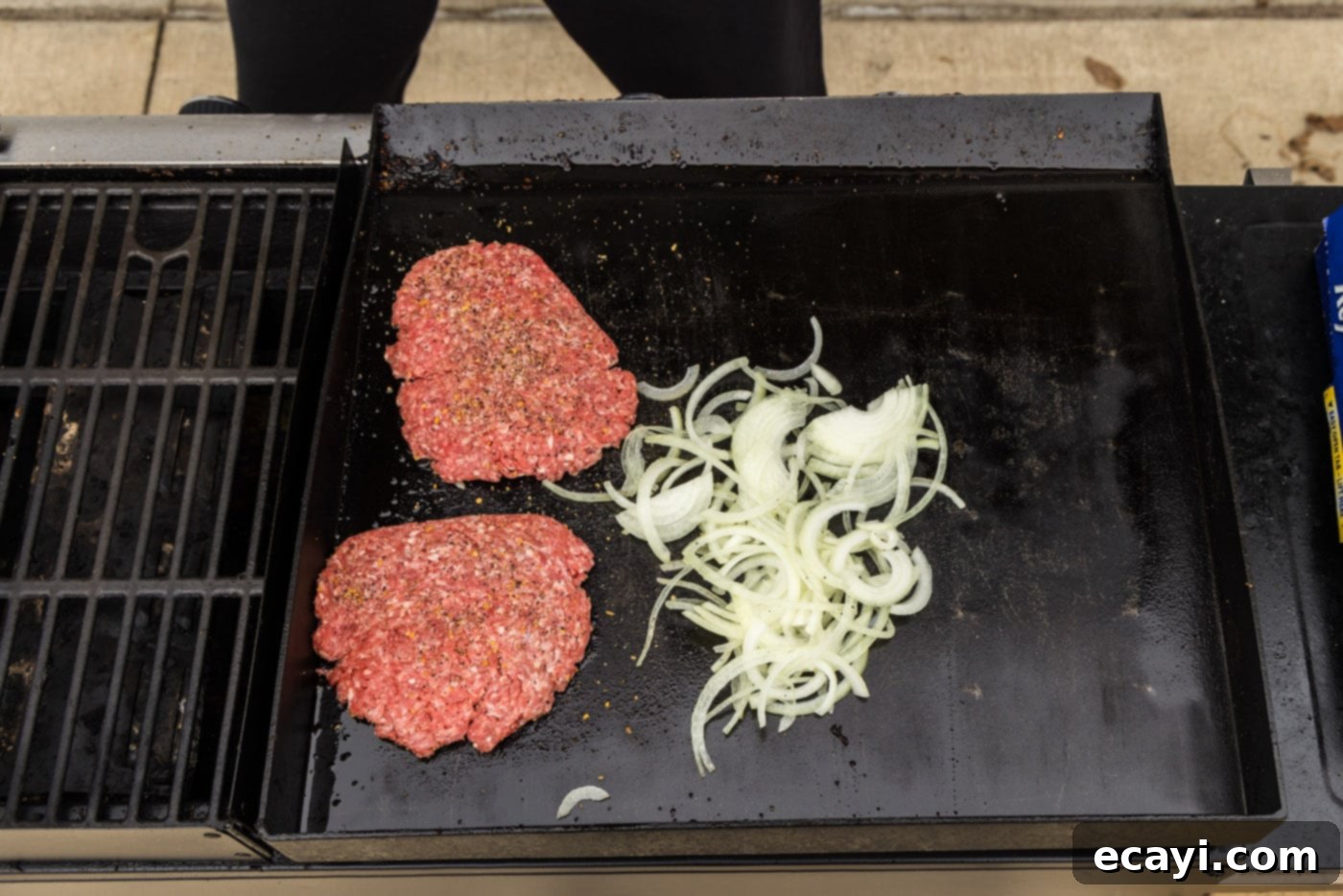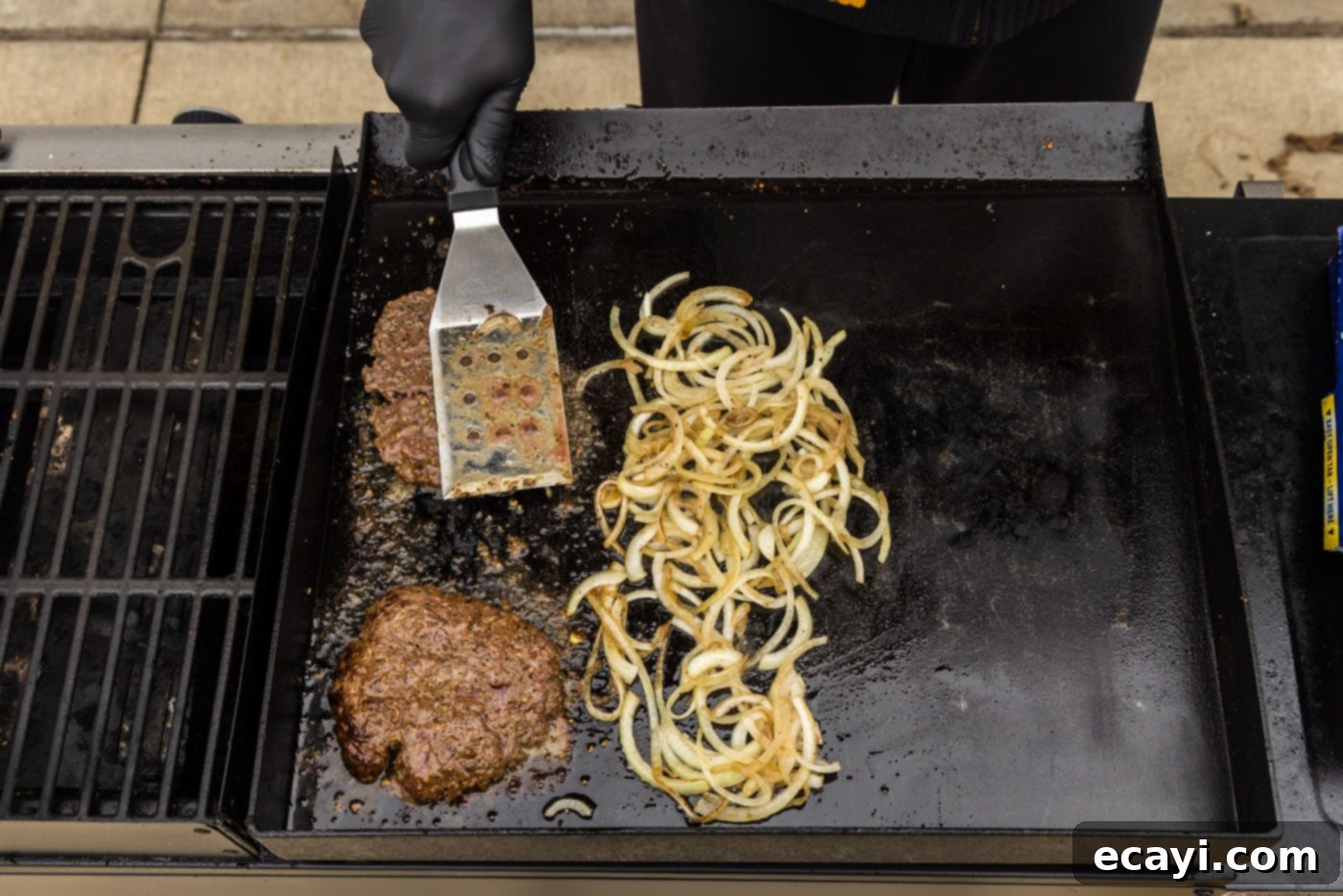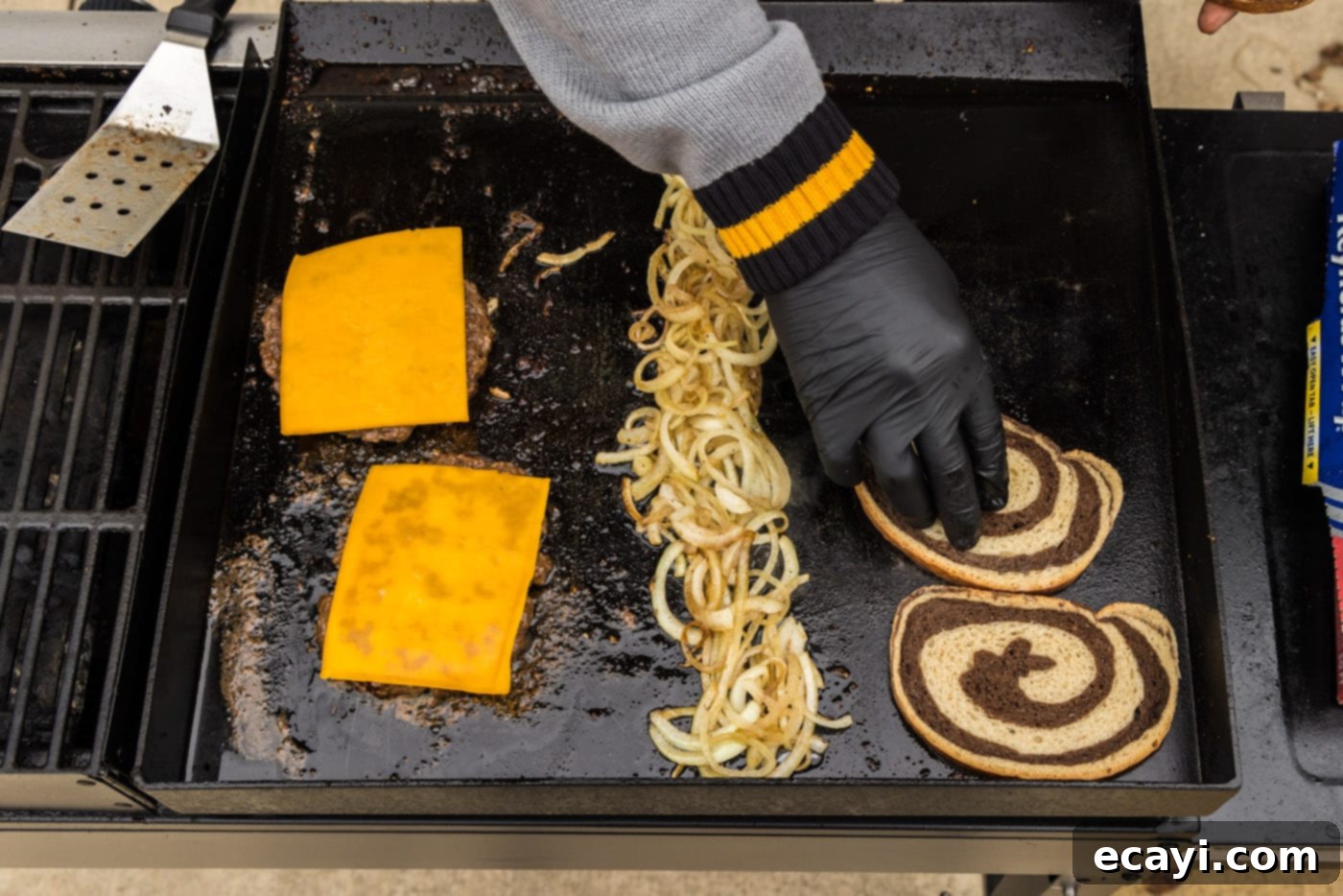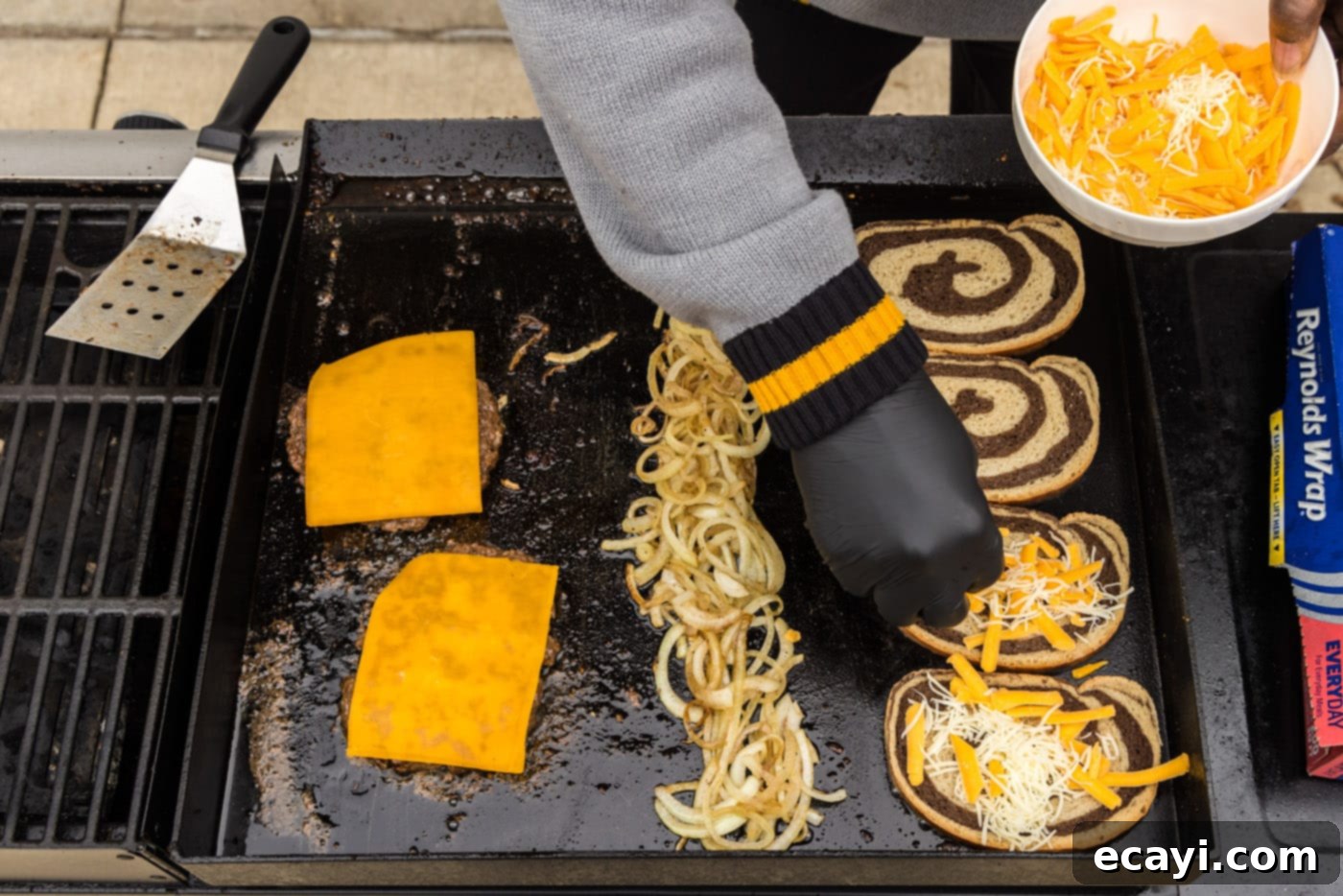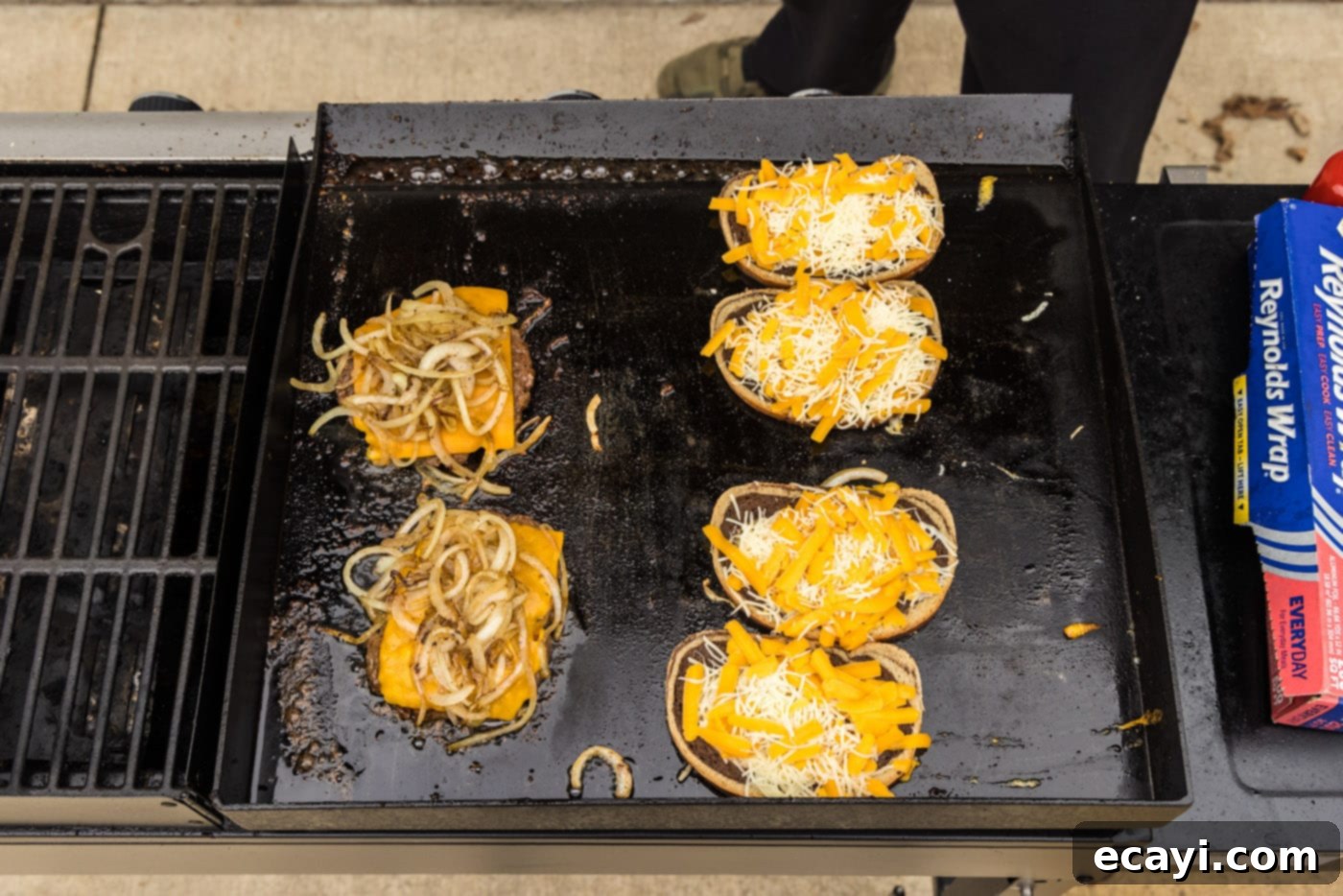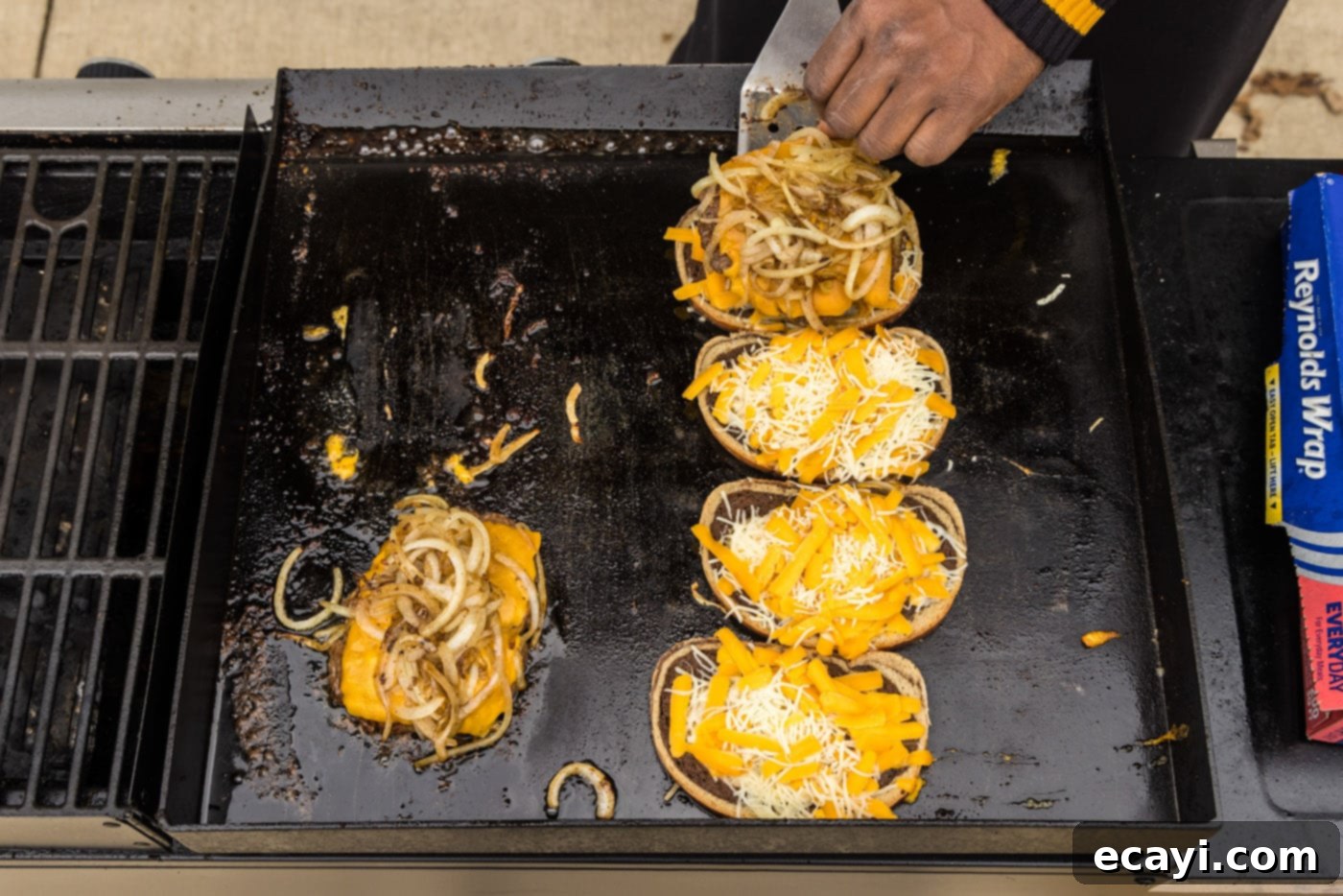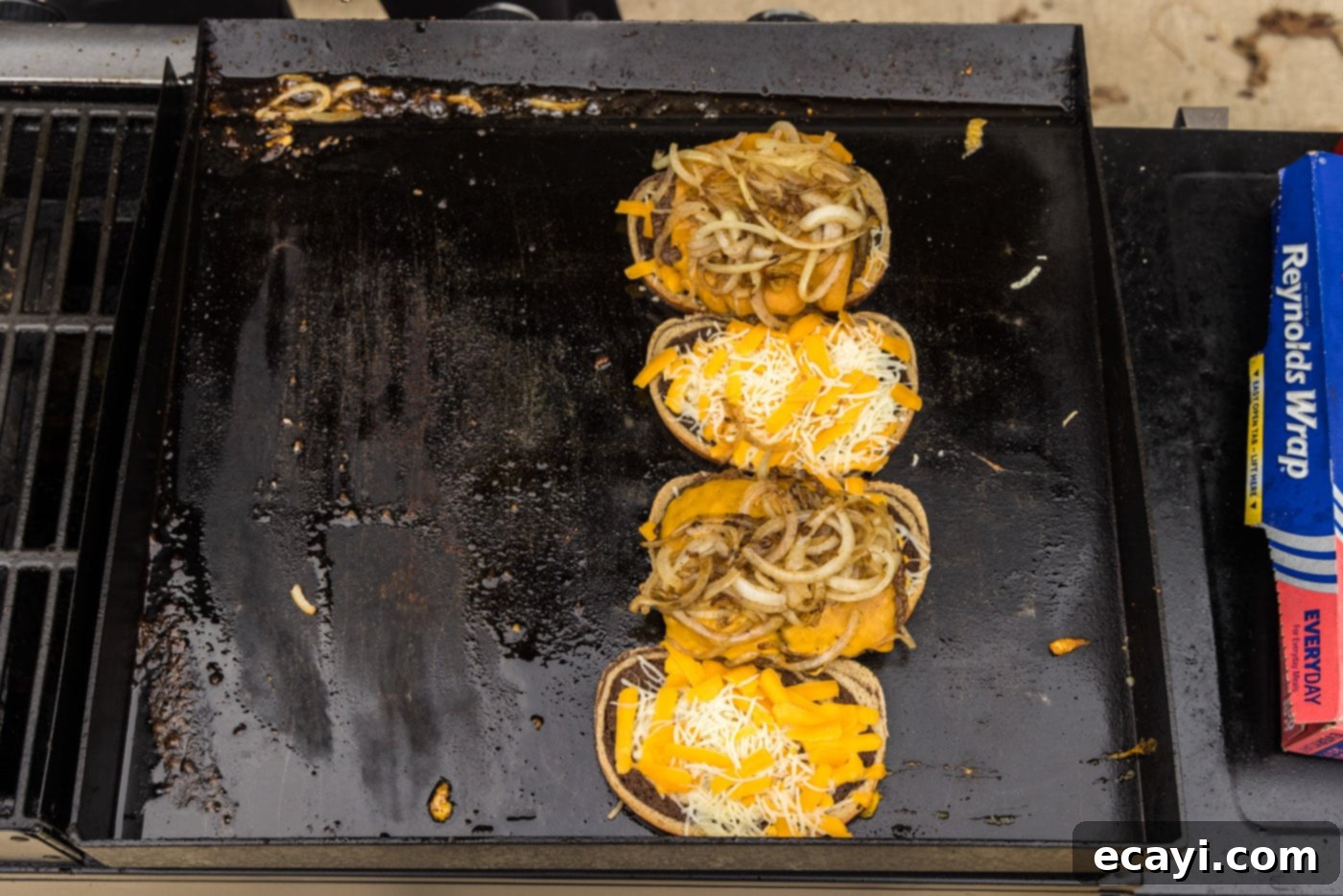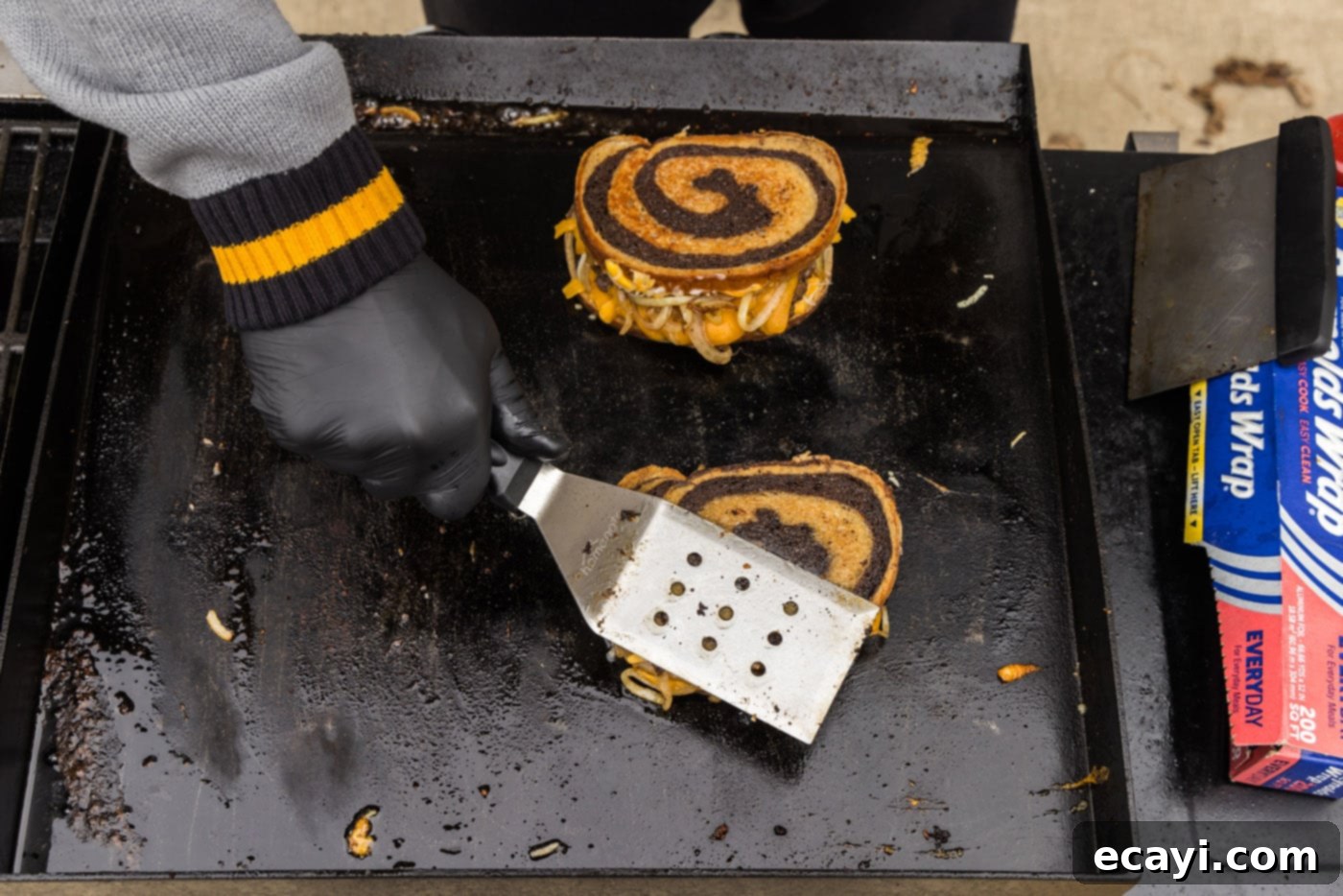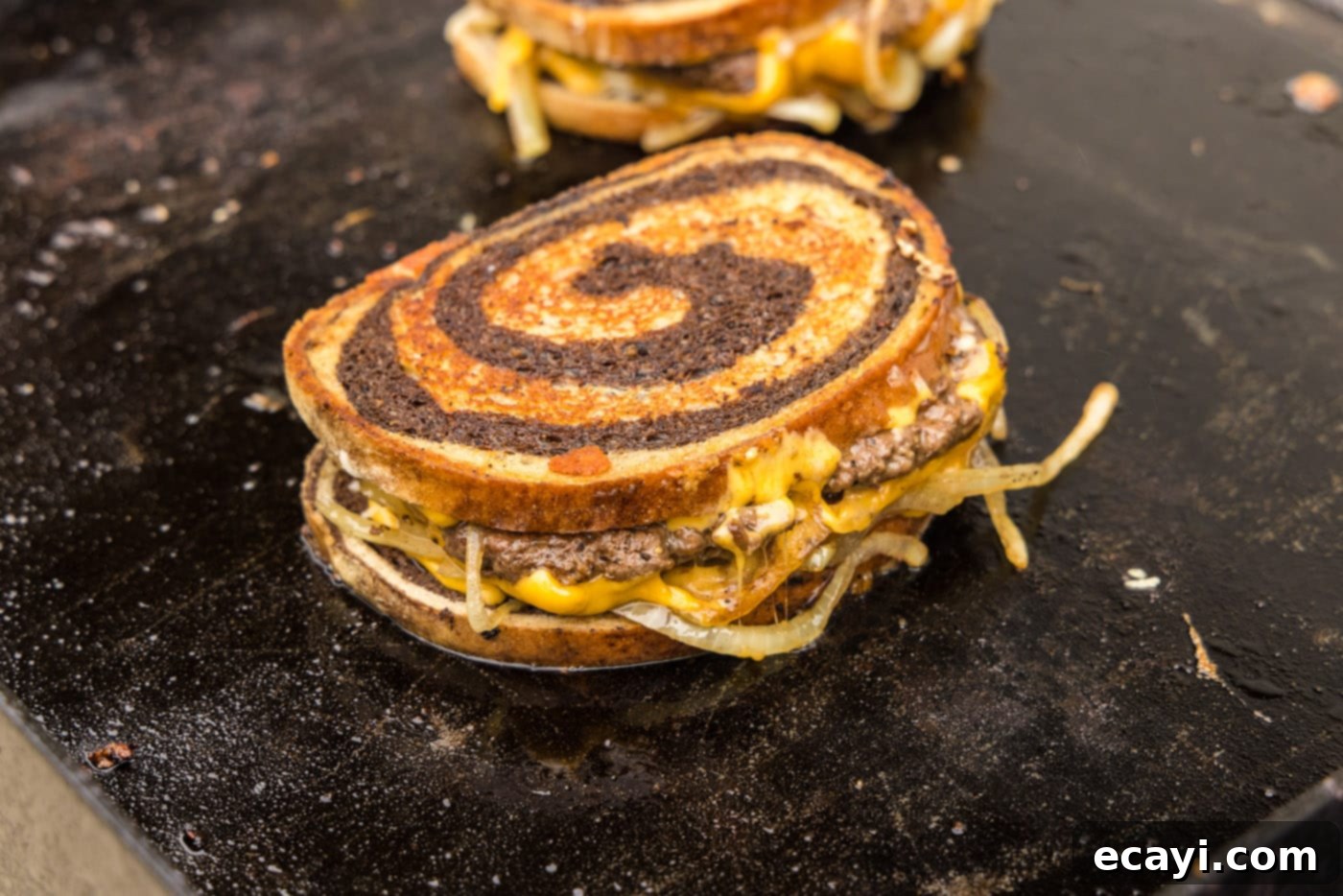The Ultimate Classic Patty Melt Recipe: A Step-by-Step Guide to Diner-Style Perfection
There’s a reason why the classic patty melt holds a cherished spot in American diner cuisine. This iconic sandwich offers a grilled burger, perfectly complemented by rich, melty cheese and tender, caramelized onions, all nestled between two slices of buttery, toasted bread. It’s a symphony of flavors and textures, delivering all the comforting goodness of a traditional burger but with an elevated, irresistible twist that makes it truly stand out. Whether you’re a long-time fan or new to this delightful creation, mastering the homemade patty melt is a culinary journey worth taking.
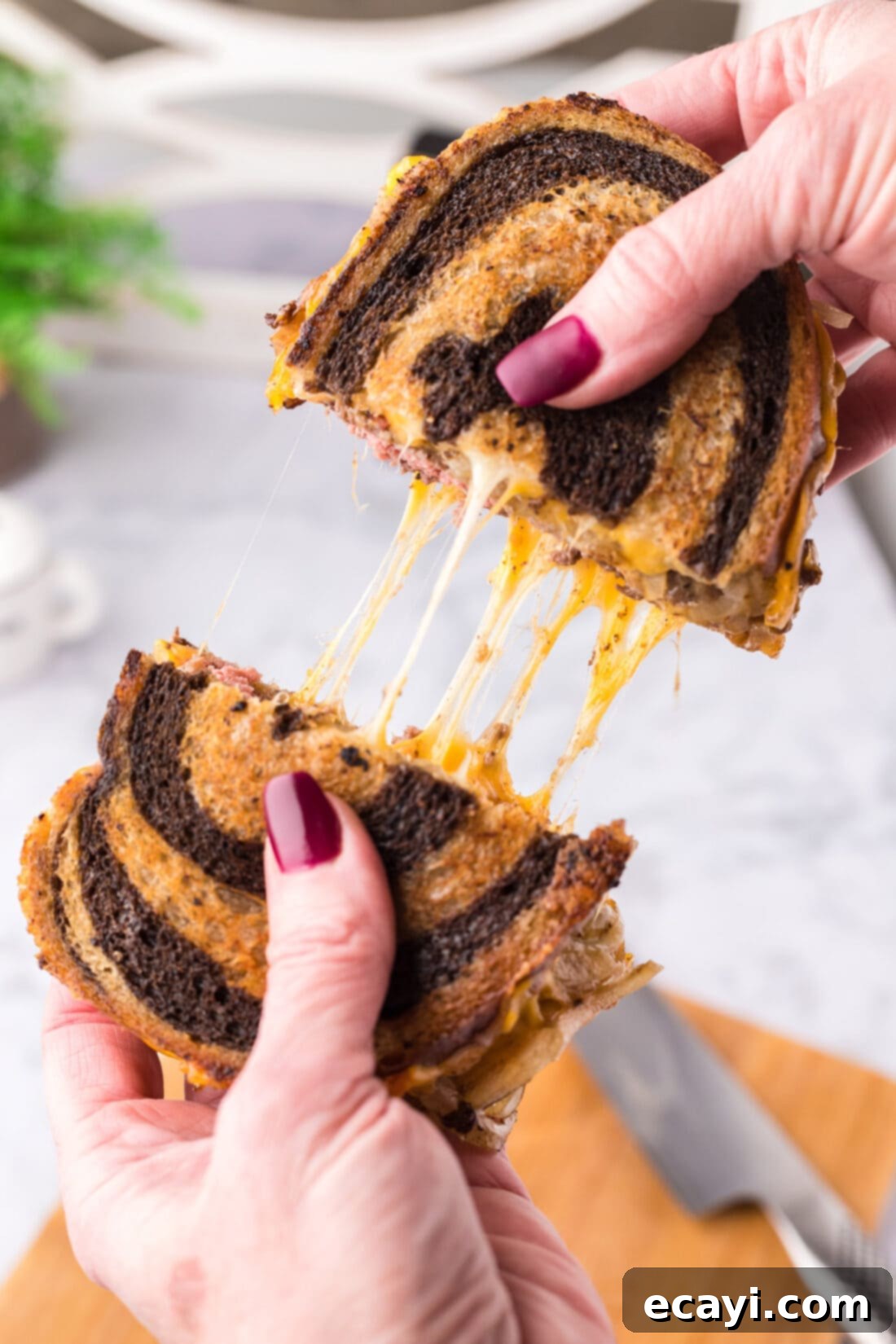
Why This Patty Melt Recipe Works
This American-style diner sandwich isn’t just popular; it’s beloved for a multitude of reasons. A truly exceptional patty melt brings all the comforting flavors of a juicy burger to your plate, but instead of confining it within a fluffy bun, it ingeniously sandwiches the patty, cheese, and onions between two hearty slices of thick, toasted bread. Every bite is an experience, beginning with a deeply satisfying crunch from the perfectly grilled, buttery bread. This gives way to the irresistible gooeyness of melty cheese, followed by the tender sweetness of slow-cooked caramelized onions, culminating in the rich, savory succulence of a juicy burger patty. This harmonious blend of textures and tastes creates a remarkably satisfying sandwich, suitable for both a hearty lunch or a comforting dinner.
The beauty of the patty melt lies in its delightful simplicity. It’s a straightforward recipe that yields impressive results, particularly when generously loaded with your favorite cheeses. While the classic combination is superb, don’t hesitate to venture beyond the traditional. For instance, adding thinly sliced pickles introduces a delightful tang and crunch, much like they would enhance a Cuban sandwich or a corned beef sandwich. Other popular additions include earthy sautéed mushrooms, a zesty smear of yellow mustard, or a generous dollop of creamy Thousand Island dressing, allowing you to tailor this iconic dish precisely to your preferences. The flexibility and comforting familiarity of the patty melt make it an enduring classic.
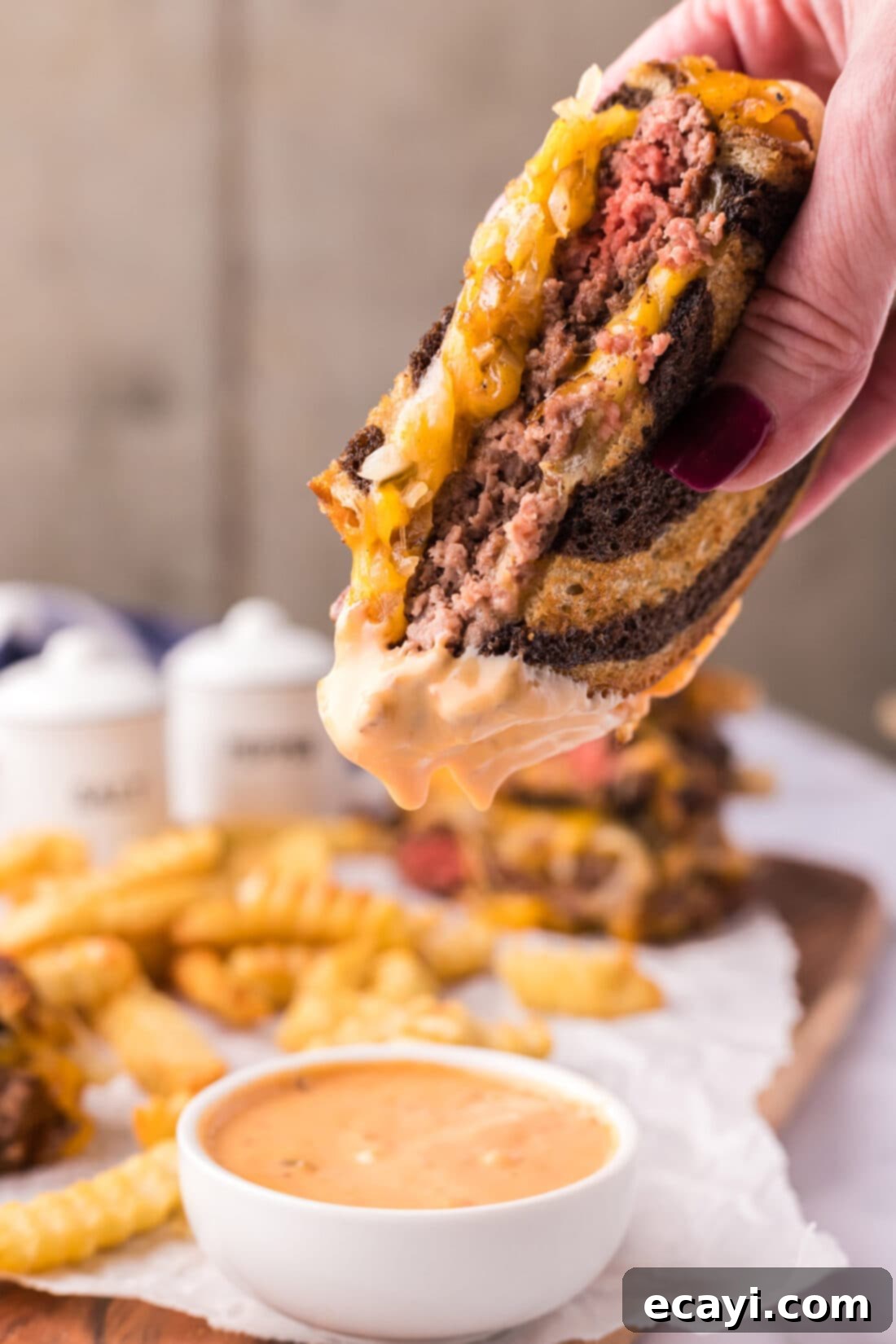
Essential Ingredients You Will Need
Crafting the perfect patty melt requires a few key components, each playing a vital role in creating that signature flavor and texture. You’ll find a detailed list of all measurements, ingredients, and comprehensive instructions in the printable version of this recipe conveniently located at the end of this post. For now, let’s explore the core ingredients that make this sandwich so special.
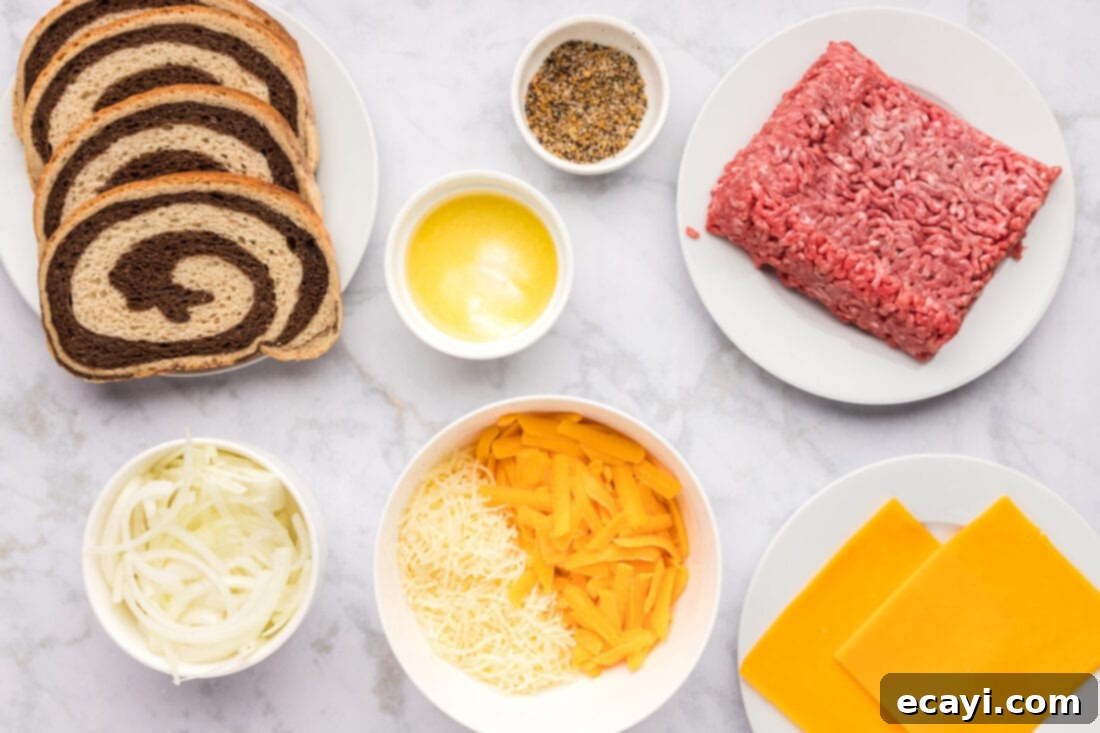
Ingredient Information and Smart Substitution Suggestions
Understanding each ingredient and its potential substitutes can elevate your patty melt from good to extraordinary. Here’s a deeper dive into the components:
BREAD – Rye bread, particularly marble rye, is the traditional and often preferred choice for patty melts. Its robust, slightly tangy flavor beautifully complements the savory beef and sweet onions, while its dense, hearty texture stands up exceptionally well to grilling and the moist fillings without becoming soggy. The sturdy nature of rye ensures a satisfying crunch and structural integrity. However, if rye isn’t your preference or is unavailable, sourdough bread makes an excellent alternative, offering a pleasant tanginess and a firm crust when toasted. For those who enjoy a thicker, more substantial sandwich, Texas toast is another fantastic option, providing extra surface area for butter and a truly decadent, crispy exterior.
CHEESE – We recommend using a harmonious blend of cheddar cheese and Swiss cheese to achieve a complex flavor profile and optimal melt. Cheddar provides a sharp, familiar tang, while Swiss offers a nutty, slightly sweet note and a fantastic stretch when melted. While this combination is a winner, feel free to personalize your cheese choice. You can certainly opt for a single type of cheese if that suits your taste. For excellent substitutes, consider Muenster cheese for a milder flavor and superb melting capabilities, Havarti for a creamy, buttery texture, or Pepper Jack if you desire a subtle spicy kick. For a classic, supremely gooey melt reminiscent of American diners, good old American cheese is always a reliable and delicious choice as a substitute for cheddar.
GROUND BEEF – The heart of your patty melt is the beef patty. For the juiciest and most flavorful results, we highly recommend using ground beef with an 80/20 or 85/15 lean-to-fat ratio. The fat content is crucial here, as it renders down during cooking, keeping the patty moist and infusing it with incredible flavor. Leaner beef (e.g., 90/10) can result in a drier patty, so aim for a slightly higher fat content for that diner-style experience. When it comes to seasoning, don’t hold back. While Montreal steak seasoning offers a fantastic blend of savory spices, a simple yet effective alternative is a generous sprinkle of coarse salt, freshly cracked black pepper, garlic powder, and onion powder on both sides of your patties.
ONIONS – The caramelized onions are non-negotiable for an authentic patty melt. This isn’t just about cooking onions; it’s about transforming their sharp, pungent flavor into something incredibly sweet, deeply savory, and tender. Patience is key here. Sautéing them slowly over medium-low heat for an extended period allows their natural sugars to develop and caramelize, creating a rich, golden-brown hue and a depth of flavor that contrasts beautifully with the beef and cheese. You’ll know they’re ready when they’re soft, translucent, and have that distinctive sweet aroma and sticky texture.
BUTTER – Melted butter is essential for achieving that irresistible golden-brown, crispy crust on your bread. It imparts a rich flavor and helps the bread toast evenly, creating a perfect textural contrast to the soft interior. While unsalted butter gives you more control over the overall sodium content, salted butter can also be used if preferred. If you’re concerned about butter burning at higher temperatures, clarified butter (ghee) is an excellent alternative due to its higher smoke point, ensuring your bread gets perfectly toasted without scorching.
How to Make the Perfect Patty Melt
These step-by-step photos and detailed instructions are designed to help you visualize how to make this delicious recipe with ease. For your convenience, you can jump directly to the printable recipe card, complete with exact measurements and full instructions, found at the very bottom of this post.
- Preheat your chosen cooking surface: a flat top grill, a sturdy griddle, or a heavy-bottomed cast iron skillet. Achieving the right temperature is crucial for a good sear on your patties and perfectly crisp bread. Ensure it’s heated to a medium-high setting.
- Begin by preparing your ground beef. Divide the total amount of ground beef into two equal pieces. Roll each piece gently into a ball. To create uniform patties, place one beef ball on a piece of parchment paper, fold the paper over to cover the ball, and then press down firmly to flatten it into an even patty, about ½-inch thick. Repeat this process for the second patty.


CHEF’S TIP – To prevent your burger patties from swelling and becoming football-shaped while they cook, use your thumb to create a shallow indentation in the very center of each patty. This simple trick helps them cook more evenly and maintain a flatter shape.

- Generously season both sides of your prepared patties with Montreal steak seasoning, or your preferred blend of salt, pepper, garlic, and onion powder.

- Take each slice of rye bread and brush one side generously with melted butter. This buttered side will be placed onto the hot cooking surface later for a golden, crispy toast.

- Carefully place the seasoned burger patties onto the preheated grill or griddle, ensuring the seasoned side goes down first to create a beautiful sear. Immediately sprinkle more seasoning on the side of the patties that is now facing up.

- Alongside the cooking burgers, place your sliced onions onto the hot flat top. Cook them slowly, turning occasionally with a spatula, until they become beautifully softened, translucent, and develop a rich, sweet caramelization. This process takes patience but is essential for the patty melt’s signature flavor.


- Once the first side of the burgers is nicely seared, turn them over to cook to your desired level of doneness (medium-rare, medium, medium-well). When the burgers are almost fully cooked, place a slice of your chosen cheese (Swiss or cheddar) directly on top of each patty, allowing it to begin melting.
- While the cheese is melting on the patties, place your buttered bread slices onto the flat top, buttered side down. Immediately add a generous ½ cup of shredded cheese (a mix of cheddar and Swiss works wonderfully here) to each slice of bread. This will create a cheesy, crispy base for your sandwich.


- Once the onions are caramelized and the cheese on the patties is melted, use a spatula to carefully transfer a portion of the grilled onions on top of each cheese-topped burger patty. Then, using your spatula, gently lift each onion-topped patty and place it onto one of the cheese-topped slices of bread that is grilling on the flat top.



- Finally, using a spatula, carefully lift the remaining cheese-topped slice of bread and place it over the burger patty and onions to complete your sandwich. Gently press down on the top of each sandwich with the spatula for a few seconds. This helps the melted cheeses adhere to each other and bind the sandwich together, ensuring a cohesive and delicious patty melt. Continue grilling until the bread is golden brown and all the cheese is gooey and melted.


Frequently Asked Questions & Expert Tips for Your Patty Melt
While the debate might rage on in some circles, a patty melt is unequivocally a sandwich. Both a burger and a patty melt feature a burger patty between two slices of bread, but their fundamental differences lie in the bread and toppings. Traditional burgers typically come with fresh toppings like lettuce, tomato, and raw onion, almost exclusively served on a dedicated burger bun. Patty melts, however, forge their own path by using two regular, hearty slices of sandwich bread (often rye or sourdough), accompanied by the star trio of grilled, caramelized onions and an abundance of perfectly melty cheese. This distinct composition firmly places the patty melt in the sandwich category, offering a unique, griddled experience that sets it apart from its bun-bound cousin.
To maintain the freshness and flavor of your leftover patty melts, store them in an air-tight container. Place the container in the refrigerator, where the sandwich will keep well for 2-3 days. For best results, it’s sometimes advisable to store the cooked patty and caramelized onions separately from the bread if you anticipate not eating them immediately, as this can help prevent the bread from becoming overly soggy.
Reheating a patty melt requires a bit of care to ensure the bread crisps up nicely and the patty warms through without becoming dry or soggy. The best methods involve indirect heat:
- Oven or Toaster Oven: Wrap the sandwich loosely in aluminum foil to prevent drying, then reheat in a 350°F (175°C) oven or toaster oven for approximately 10 minutes, or until thoroughly warmed. For a crispier crust, you can remove the foil for the last few minutes of reheating.
- Air Fryer: Similar to an oven, an air fryer can work wonders. Place the patty melt (you can keep it unwrapped or lightly wrapped in foil) in the air fryer basket and heat at 325-350°F (160-175°C) for about 5-7 minutes, checking periodically.
Reheating in a skillet can be tricky, as the sandwich’s layered nature often means the bread gets re-toasted while the interior patty remains cold, unless you deconstruct the sandwich first. Microwaving is generally not recommended, as it will almost certainly result in soggy bread and an undesirable texture for the entire sandwich.
Expert Tips for Patty Melt Perfection:
- Patience with Onions: Don’t rush the caramelization process for your onions. Low and slow heat is the secret to unlocking their deep, sweet flavor and achieving that desirable tender texture. This step genuinely makes a huge difference in the final taste.
- Quality Bread Matters: Since the bread forms a significant part of the patty melt, acting as the “bun,” choose a high-quality rye, sourdough, or Texas toast. The texture and flavor of your bread will greatly influence the overall enjoyment of the sandwich.
- Monitor Heat: Keep a close eye on your grill or griddle temperature. Too high, and your bread might burn before the cheese melts or the patty cooks through. Too low, and you won’t get that satisfying golden-brown crust. Adjust as needed.
- Gentle Pressing: When assembling the sandwich and pressing it down with a spatula, do so gently. The goal is to help the cheeses meld and secure the layers, not to flatten the burger patty completely.
- Customize to Your Heart’s Content: While classic is great, don’t be afraid to experiment. Add a slice of your favorite hot pepper, a dab of spicy mustard, or a few pickles for an extra burst of flavor and texture.
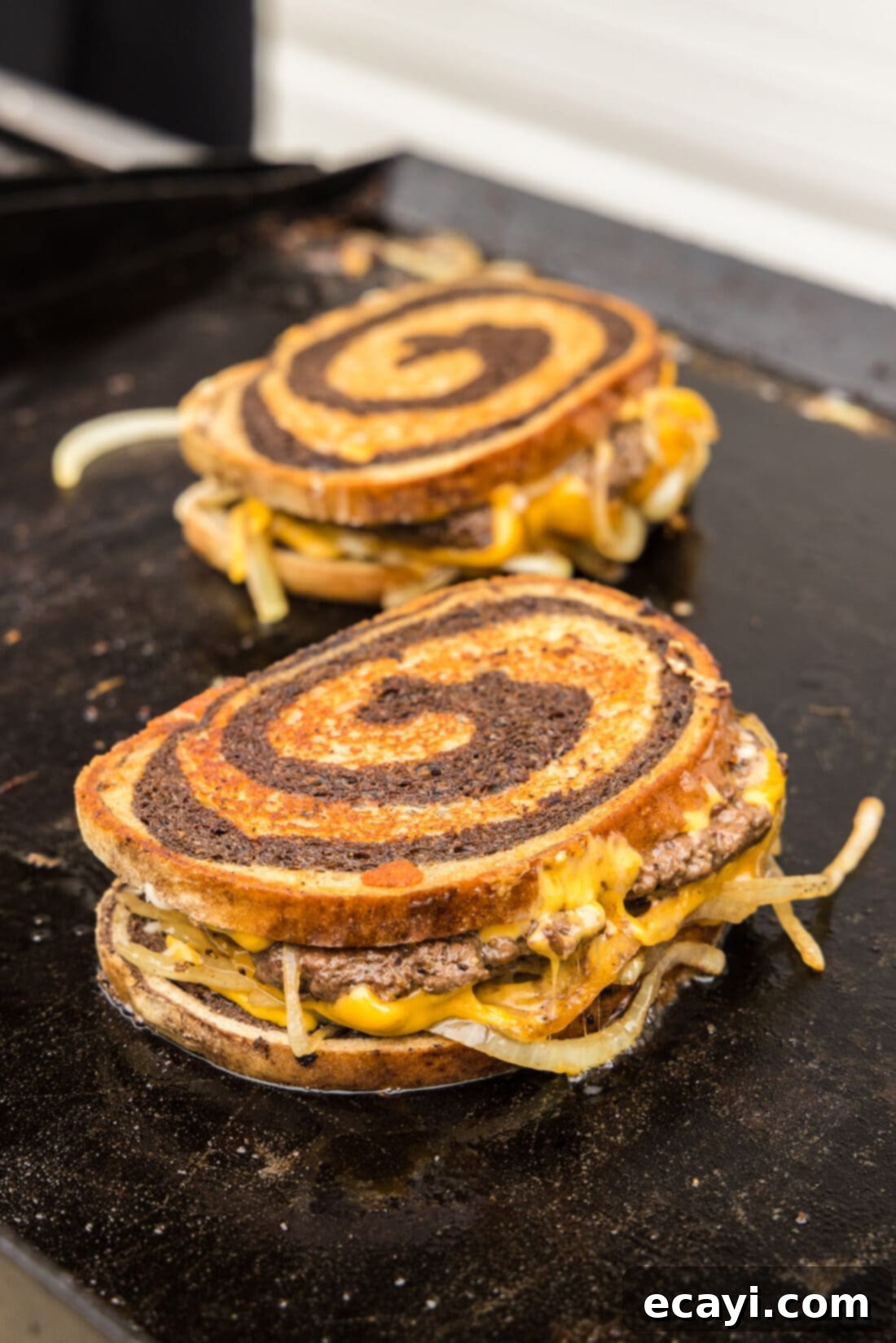
Delicious Serving Suggestions
A phenomenal patty melt deserves equally delightful accompaniments. For a classic diner experience, serve your warm, gooey sandwich alongside a generous portion of crispy French fries or a handful of crunchy potato chips. A crisp pickle spear is almost mandatory, offering a tangy counterpoint to the rich flavors of the melt. To elevate the experience even further, consider pairing your patty melt with a side of creamy Thousand Island dressing, tangy yellow mustard, or a rich mayo for dipping, or you can even smear these dressings directly onto the bread for an added layer of flavor. Other excellent side dishes include a fresh coleslaw, onion rings, or a simple green salad to balance the richness. For beverages, nothing beats a classic milkshake or a cold soda, but for adult palates, a crisp lager or amber ale can also be a fantastic pairing. Enjoy your patty melt fresh off the griddle or grill, savoring every comforting bite.
More Irresistible Sandwich Recipes
If you love the satisfying experience of a well-crafted sandwich, you’re in luck! Here are some other fantastic recipes that are sure to become new favorites:
- Tuna Melt
- Cuban Sandwich
- Reuben Sandwich
- Roast Beef Sandwich
- Corned Beef Sandwich
- Monte Cristo Sandwich
I love to bake and cook and share my kitchen experience with all of you! Remembering to come back each day can be tough, that’s why I offer a convenient newsletter every time a new recipe posts. Simply subscribe and start receiving your free daily recipes!
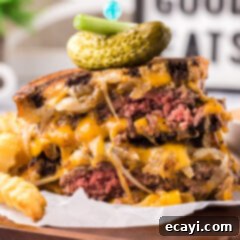
Patty Melt
IMPORTANT – There are often Frequently Asked Questions and Expert Tips within the blog post that you may find incredibly helpful. Simply scroll back up to read them!
Print It
Pin It
Rate It
Save ItSaved!
Ingredients
- 4 slices marble rye bread
- ⅔ pound ground beef 85/15 (or 80/20 for juicier results)
- 1 cup sliced onion 1 medium onion, thinly sliced for caramelization
- 2 Tablespoons Montreal steak seasoning divided (or salt, pepper, garlic powder to taste)
- 4 Tablespoons melted butter (for buttering the bread)
- 2 slices cheese Swiss or cheddar for topping the burger patties
- ½ cup shredded cheddar cheese (for the bread)
- ½ cup shredded Swiss cheese (for the bread, or use all cheddar for a more unified flavor)
Things You’ll Need
-
Flat top grill or a heavy cast iron skillet/griddle for excellent heat retention and searing.
-
Parchment paper (helpful for flattening patties cleanly)
-
Basting brush (for even butter application)
Before You Begin (Chef’s Notes)
- Rye bread has a nice hearty weight to it, making it ideal for patty melts due to its ability to hold up to the moist fillings and achieve a great crunch. You can also try sourdough for a tangy twist or even Texas toast for a thicker, more indulgent sandwich.
- We like to use a combination of sharp cheddar and nutty Swiss cheese for a complex flavor profile, however, you can certainly opt for all of the same type of cheese if preferred. Muenster, Havarti, and pepper jack are all great substitutes for the Swiss, while American cheese is a classic and excellent sub for the cheddar, offering superior melt.
- For optimal juiciness and flavor in your burger patties, select ground beef with an 80/20 or 85/15 lean-to-fat ratio. This fat content ensures a moist and delicious patty.
- Store any leftover patty melts in an air-tight container kept in the refrigerator for 2-3 days. For best results, consider storing components separately if you want to preserve the crispness of the bread for reheating.
- To reheat a patty melt, wrap the sandwich with aluminum foil and warm it in a 350°F (175°C) oven, air fryer, or toaster oven for around 10 minutes or until warmed through. You can remove the foil towards the end to help the bread crisp back up. Reheating in a skillet may only toast the bun, leaving the patty cold, unless you deconstruct it. Reheating in the microwave will likely leave the bread soggy and is generally not recommended for best texture.
- Don’t rush the caramelization of the onions. This slow process is key to developing their sweet, deep flavor which is essential for a true patty melt.
- To prevent your burger patties from bulging in the center, press a small indentation into the middle of each patty with your thumb before cooking. This ensures a flatter, more even patty.
Instructions
-
Preheat your flat top grill, electric griddle, stove top flat top, or cast iron skillet to a medium-high heat. A properly preheated surface is vital for achieving a good sear on the meat and crispy bread.
-
Divide the ground beef into two equal portions. Gently roll each portion into a ball. Place one beef ball on a piece of parchment paper, fold the paper over, and press down firmly to flatten it into a ½-inch thick patty. Repeat for the second patty, ensuring even thickness for uniform cooking.
CHEF’S TIP – To prevent the center of your patty from swelling and creating an uneven shape during cooking, press your thumb into the center to create a slight indentation.
-
Generously season both sides of the burger patties with Montreal steak seasoning, or a blend of salt, pepper, garlic powder, and onion powder to your taste.
-
Brush one side of each slice of bread thoroughly with melted butter. This buttered side will be placed onto the cooking surface to achieve a golden, crisp texture.
-
Place the seasoned patties on the preheated grill or griddle, seasoned side down, to start cooking. Immediately sprinkle the unseasoned side (now facing up) with more seasoning.
-
Place the thinly sliced onions on the flat top next to the burgers. Cook them slowly over medium-low heat, turning occasionally with a spatula, until they are deeply caramelized, sweet, and tender (this will take longer than the burgers).
-
Flip the burgers and continue cooking to your desired doneness. When the burgers are nearly finished cooking, place a slice of cheese (Swiss or cheddar) on top of each patty and allow it to melt. You can cover the patties briefly to help the cheese melt faster.
-
While the cheese is melting on the patties, place the buttered bread slices onto the flat top (buttered side down). Immediately add ½ cup of shredded cheese (a blend of cheddar and Swiss) to each slice of bread. Grill until the bread is golden and the cheese is bubbly.
-
Once the onions are perfectly caramelized, transfer them from the flat top and distribute them evenly over the cheese-topped burger patties. Then, using a spatula, carefully lift each onion-topped patty and place it onto one of the grilled, cheese-topped slices of bread.
-
With a spatula, gently lift the other cheese-topped slice of bread and place it carefully over the burger patty, completing the sandwich. Lightly press the top of each sandwich with the spatula to help the melted cheeses adhere together and bind the layers. Continue to grill for another minute or two, ensuring all cheese is perfectly melted and the bread is golden brown. Serve immediately and enjoy!
Nutrition Information
The recipes on this blog are tested with a conventional gas oven and gas stovetop. It’s important to note that some ovens, especially as they age, can cook and bake inconsistently. Using an inexpensive oven thermometer can assure you that your oven is truly heating to the proper temperature. If you use a toaster oven or countertop oven, please keep in mind that they may not distribute heat the same as a conventional full sized oven and you may need to adjust your cooking/baking times. In the case of recipes made with a pressure cooker, air fryer, slow cooker, or other appliance, a link to the appliances we use is listed within each respective recipe. For baking recipes where measurements are given by weight, please note that results may not be the same if cups are used instead, and we can’t guarantee success with that method.
